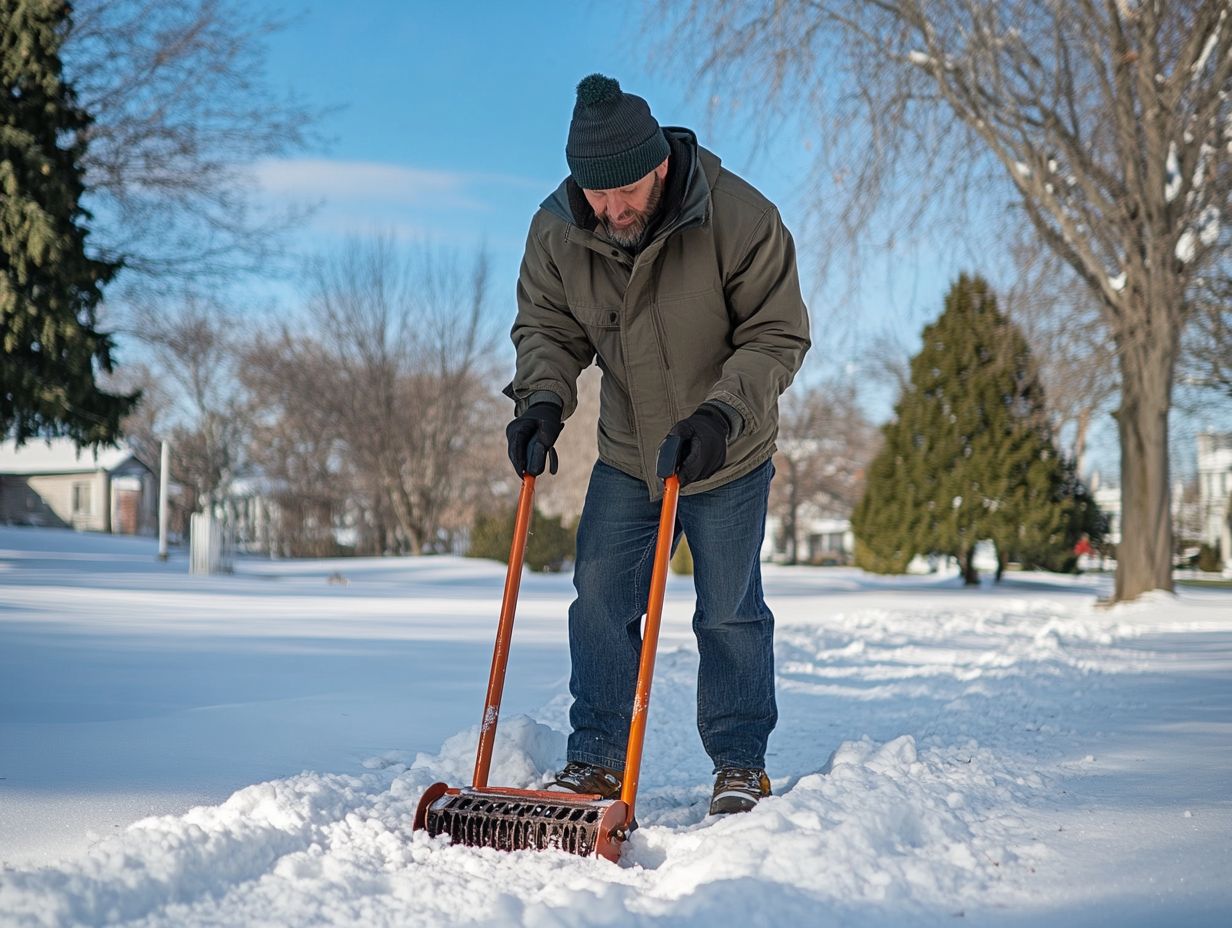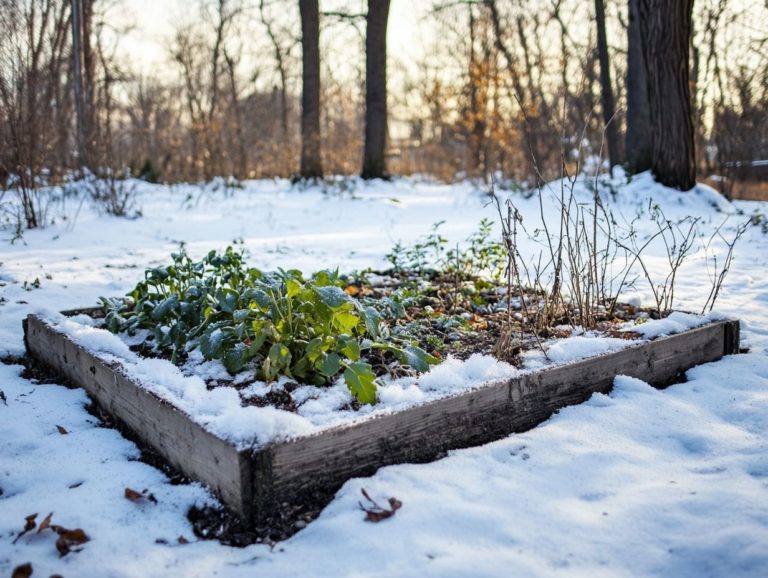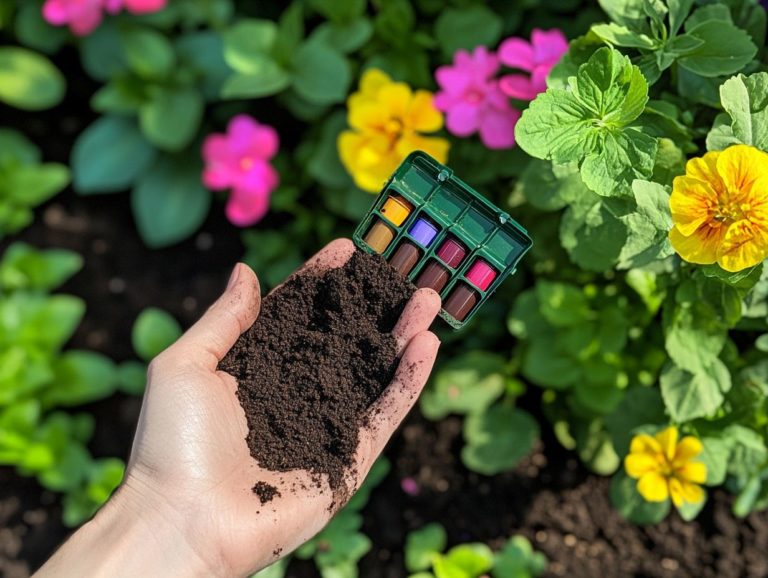Techniques for Soil Aeration in Cold Climates
Soil aeration is essential for fostering healthy plant growth. Yet, it often brings distinct challenges in colder climates.
By enhancing soil aeration, you can significantly improve root development. This, in turn, affects your plants’ overall health.
This article delves into the importance of soil aeration, the various factors that influence it, and the most effective methods for achieving optimal aeration in chilly conditions.
Whether you prefer mechanical techniques or natural solutions, you’ll find guidance on selecting the right approach for different soil types. You ll also learn how to maintain optimal aeration throughout the year.
Join us as we explore the secrets to nurturing thriving plants, even in the cold! You won’t want to miss these tips!
Contents
- Key Takeaways:
- The Importance of Soil Aeration
- Facing the Cold: Challenges of Soil Aeration
- Methods for Soil Aeration in Cold Climates
- Choosing the Right Aeration Technique
- Maintaining Soil Aeration in Cold Climates
- Frequently Asked Questions
- What is soil aeration and why is it important in cold climates?
- What are some techniques for soil aeration in cold climates?
- When is the best time to aerate soil in cold climates?
- Do I need any special equipment for soil aeration in cold climates?
- How often should I aerate my soil in cold climates?
- What are the benefits of soil aeration in cold climates?
Key Takeaways:

- In cold climates, soil aeration is crucial for promoting healthy plant growth by improving air and water nutrient absorption in the soil.
- Factors like frozen ground and heavy snowfall can make soil aeration challenging, but mechanical and natural techniques can help overcome these obstacles.
- When choosing an aeration technique, consider the type of soil you have and its specific needs.
The Importance of Soil Aeration
Soil aeration is an essential practice for maintaining the health of your lawn, especially during the winter months. Cold weather can worsen soil compaction and impede grass growth.
By engaging in winter lawn aeration, you can effectively relieve soil compaction and improve drainage. This process also enhances nutrient uptake for your landscape.
This practice not only helps prevent thatch buildup a layer of dead grass and roots but also stimulates root development. It greatly improves the resilience of different grass types, including grasses that grow well in cooler weather and grasses that thrive in warmer weather.
With proper aeration, you can ensure overall lawn resilience, even in challenging conditions.
Benefits for Plant Growth
The benefits of soil aeration for plant growth are numerous and significant. Aeration enhances nutrient uptake and improves water absorption, both essential for nurturing robust grass roots.
By reducing soil compaction, aeration allows air to penetrate deeper into the ground. Aeration techniques stimulate root growth and enhance overall soil conditions.
This not only promotes healthier plants but also fosters stronger drought resistance and boosts disease resilience.
For example, studies indicate that cool-season grasses, such as Kentucky bluegrass, can experience up to a 30% improvement in root depth when aerated compared to those in non-aerated soil. Likewise, warm-season grasses like Bermuda grass flourish in looser soil, demonstrating enhanced nutrient absorption and overall vigor.
This highlights why aeration is a game-changer for lawn care!
Facing the Cold: Challenges of Soil Aeration
Soil aeration poses distinct challenges in cold climates. Freezing temperatures can intensify soil compaction and restrict effective lawn aeration techniques throughout the winter months.
This limitation can impede critical cold-weather lawn care practices essential for nurturing healthy landscapes and fostering resilient grasses.
Factors Affecting Soil Aeration

Several factors can significantly impact the efficiency of soil aeration, including soil compaction, drainage capabilities, temperature fluctuations, and moisture content. Understanding these elements is essential for anyone dedicated to maintaining a vibrant and healthy lawn.
Soil compaction stifles root growth and restricts the flow of vital nutrients and air. Proper drainage ensures that excess water does not overwhelm the roots. Temperature fluctuations affect your soil; extreme heat or cold may disrupt the activity of tiny living organisms in the soil that help plants grow. Striking a balance in moisture content is equally important too little moisture can leave your lawn parched, while too much can lead to waterlogged conditions that suffocate roots.
By embracing core aeration, refining your watering techniques, and diligently monitoring soil conditions, you can transform your lawn into a lush, green paradise!
Methods for Soil Aeration in Cold Climates

In cold climates, effective soil aeration methods encompass both mechanical and natural techniques designed to tackle the unique challenges posed by dormant lawn care during winter. It’s also important to understand soil drainage needs to ensure optimal growth when the seasons change.
Understanding these options is key for ensuring your lawn remains healthy and resilient throughout the season.
Mechanical Aeration Techniques
Mechanical aeration techniques involve specialized equipment designed to relieve soil compaction. This significantly enhances root stimulation and overall lawn health. These methods are particularly advantageous in colder climates, where dense soils can stifle the natural growth of grassroots.
By utilizing various types of mechanical aerators like core aerators that remove plugs of soil and spike aerators that create holes you can refine your lawn care practices. Core aerators not only relieve compaction but also facilitate the deeper penetration of essential nutrients, water, and air into the soil, fostering healthier turf. While spike aerators may be simpler to operate, they often yield less benefit for soil health.
Aerate during optimal seasonal windows, typically in the fall or early spring. Following up with overseeding encourages thicker grass growth, enhancing the overall beauty and vitality of your lawn.
Natural Aeration Methods
Natural aeration methods emphasize enhancing soil health through organic practices. These practices are essential for promoting a vibrant lawn and enriching soil biology, contributing to overall lawn resilience.
By adding organic matter like compost or incorporating cover crops, you can cultivate a balanced ecosystem that nurtures beneficial microorganisms and enhances soil structure. These approaches promote better water infiltration and ensure that vital nutrients are readily accessible to plants, all without relying on mechanical aeration tools.
Embracing these natural techniques and boosting microbial diversity positively impacts the environment by reducing soil erosion and improving carbon sequestration. This ultimately creates a more resilient and productive landscape.
Choosing the Right Aeration Technique
Choosing the right aeration technique can unlock amazing benefits for your lawn! Selecting the appropriate aeration technique is crucial, as different soil types may demand customized approaches to truly enhance the overall health of your lawn.
Considerations for Different Soil Types
Choosing the right aeration technique depends on your soil type. Factors like packed-down soil, drainage, and nutrient absorption can greatly affect your lawn care success.
Clay soil has a compact structure. It often requires special aeration methods to relieve compaction and improve water and nutrient flow.
Sandy soil, on the other hand, drains well. It may need less frequent aeration; instead, adding organic matter can improve its nutrient retention.
Loamy soil is known for its balanced texture. It benefits from a regular aeration schedule to promote healthy grass growth by encouraging deeper roots.
Maintaining Soil Aeration in Cold Climates
Maintaining soil aeration in cold climates demands a thoughtful strategy that encompasses best practices for achieving long-lasting aeration. This approach promotes the resilience of your lawn and ensures its vitality through the shifting seasons.
Best Practices for Long-Term Aeration
Implementing best practices for long-term aeration is crucial to ensure healthy grass roots and achieve optimal lawn health while considering fertilizer application.
By adhering to a consistent aeration schedule typically once or twice a year you ll significantly enhance your soil’s ability to absorb water and nutrients. Timing is essential; early spring or fall are often the most advantageous times for aeration.
Pairing this practice with regular fertilization and overseeding amplifies the benefits of aeration, resulting in a denser and more resilient lawn. This combination fosters robust root development, allowing your grass to better endure stressors such as drought, pests, and diseases.
Ultimately, these efforts will transform your lawn into a vibrant, lush landscape that you can take pride in.
Frequently Asked Questions
What is soil aeration and why is it important in cold climates?
Soil aeration is the process of creating air spaces in the soil to allow for better air and water circulation. In cold climates, soil can become compacted and frozen, making it difficult for plants to get the nutrients and oxygen they need. Aeration helps improve soil structure and promotes healthy plant growth. It also plays a crucial role in relieving soil compaction and enhancing drainage.
What are some techniques for soil aeration in cold climates?
One technique is using a spike or tine aerator to poke holes in the soil. Another method is core aeration, which removes small plugs of soil from the ground. You can also try topdressing with compost or using a mechanical aerator for larger areas. These aeration techniques enhance nutrient uptake and promote root stimulation.
When is the best time to aerate soil in cold climates?
The best time to aerate soil in cold climates is in early spring or late fall. This is when the ground is not frozen but still cool enough to prevent weed growth. Proper timing is essential, as avoiding aeration during periods of extreme heat or drought helps maintain lawn health and overall resilience.
Do I need any special equipment for soil aeration in cold climates?
You should use a mechanical aerator for larger areas. For smaller gardens or lawns, a manual spike or tine aerator works well. A compost spreader or shovel is also handy for spreading compost on the soil.
How often should I aerate my soil in cold climates?
The frequency of aeration depends on your soil s condition. If it’s heavily compacted, aerate twice a year. For regular maintenance, aerate once a year in early spring or late fall. Keep an eye on your soil! Adjust your aeration schedule as needed to keep it healthy.
What are the benefits of soil aeration in cold climates?
Soil aeration helps regulate moisture and reduces the risk of waterlogging. It improves nutrient absorption and promotes deeper root growth. Plus, it helps manage the layer of dead grass and roots that can block water and nutrients. These benefits are essential for maintaining a healthy landscape!
Start aerating your soil today for a healthier garden tomorrow!






